Kodokan Judo is the foundation of modern sport judo, which became an Olympic sport in 1964.
It is the official style, balancing throws and ground control techniques, and is regulated by the International Judo Federation (IJF). Kodokan Judo utilizes throws and techniques to immobilize and control opponents on the ground.
Kodokan Judo is a complete martial art.
Kodokan Judo is built upon three fundamental principles:
JU NO RI – THE PRINCIPLE OF ADAPTABILITY
This concept is based on using flexibility, suppleness, and adaptability to overcome brute strength.
SEIRYOKU ZENYO – MAXIMUM EFFICIENCY OF ENERGY :
The art of doing more with less, using energy wisely and efficiently. This principle emphasizes that intelligence and adaptability always surpass brute force.
JITA YUWA KYOEI – MUTUAL WELFARE AND BENEFIT :
True individual progress is based on cooperation rather than the sacrifice of others.
Kodokan Judo also includes kata, which are a more traditional and technical form of judo, designed to deepen understanding of the art. Unlike randori (free practice), kata is a technical demonstration performed with precision and discipline.
Kosen Judo has influenced disciplines such as Brazilian Jiu-Jitsu (BJJ) due to its ground-based strategies and submission techniques.
Kosen Judo is a variant of judo that emphasizes ground fighting and submissions. While it is less widespread than Kodokan Judo or BJJ, Kosen Judo has gained interest among grappling practitioners and judokas looking to enhance their ground-fighting skills.
There are, of course, differences between these two ground-based styles of judo:
Kosen Judo focuses on fluid transitions, advanced control techniques, and a stronger emphasis on chokes compared to Kodokan Judo.
It incorporates techniques that influenced Brazilian Jiu-Jitsu, such as open guards, complex guard positions, and joint locks that extend beyond just arm locks.
Since groundwork is the primary focus, fighters can stay on the ground longer before being forced to return to a standing position.
Whether you choose to practice Kodokan Judo or Kosen Judo, it’s all still Judo! You can even practice both styles, as nothing prevents you from doing so. The main goal remains the same: to enjoy yourself and improve!
Grappling : a form of combat based on gripping, controlling, throwing, and submitting an opponent to bring them to the ground and neutralize them without striking.
Judo q&a
question about
Kodokan & Kosen Judo
At what age can you start practicing judo?
You can start practicing judo as early as age 5, but some clubs offer specially adapted classes from age 3, known as “baby judo.” The key is to find a class that matches the child’s physical and mental development, with a focus on play and safety.
What style of judo is practiced around the world?
Kodokan Judo
This style is the most widespread and forms the foundation of modern judo. Kodokan judo emphasizes throwing techniques (nage-waza), groundwork techniques (ne-waza), as well as philosophical aspects such as respect, discipline, and self-control.
Are there team competitions in judo?
Yes! There are even team competitions now included in the Olympic program! These are mixed team events, where men and women form one team to compete against another team. Each fighter is from a different weight category and competes against the opponent of the same weight class from the other team. The women face the women, and the men face the men — each match and point earned goes toward their team’s overall score.
Why are there two different styles of judo?
Kosen Judo (focused on groundwork), places greater emphasis on ground control techniques (ne-waza) and a deeper learning of each technique, outside the competitive framework found in Kodokan judo.
Who invented judo?
Judo was invented by Jigoro Kano in 1882 in Japan. He wanted to create a more modern and educational method by drawing inspiration from jiu-jitsu techniques while eliminating the most dangerous aspects. He aimed to create a system that would be both an effective martial art and a method of physical, mental, and moral education.
What is the Kodokan?
The Kodokan is the dojo (training center) founded by Jigoro Kano in 1882 in Tokyo, Japan, and it is considered the birthplace of modern judo. The term “Kodokan” literally means “the place to study the way.”
The Kodokan is, therefore, the school where one studies the way of judo!
Is it possible to go to the Kodokan?
Yes, it is possible to visit and train at the Kodokan in Tokyo, which is open to judokas from all over the world. The Kodokan Judo Institute, founded by Jigoro Kano in 1882, is now a world-renowned training center and an iconic place for all judo enthusiasts. The Kodokan welcomes visitors and judokas of all levels, and it is possible to participate in training sessions or simply visit the place to learn more about the history of judo. The Kodokan also has a museum and a library dedicated to the history of judo and its development. These facilities offer the opportunity to discover historical artifacts and documents related to the evolution of judo, the life of Jigoro Kano, and major competitions.
What is the meaning of the Kodokan logo?
The Kodokan logo, with its octagonal shape or eight-petaled flower, symbolizes harmony, balance, mutual prosperity, and the constant pursuit of improvement — all fundamental concepts of judo as taught by Jigoro Kano.

